I am excited to begin in this issue with a three part mini-series
entitled, “Dorm Life with Engineering Students.”
These stories have come from my favorite and most trustworthy
source of humorous engineering stories, Steve Jensen (of Steve
Jensen Consultants, Inc.). Steve assures me that these stories
have/have not been greatly embellished over time in order
to clarify/add humor to the actual/imagined events. Part 1,
“Special Power,” also includes some important background
information. The stories are narrated from Steve’s perspective.
Special Power
When reading these accounts, one must remember that the state
of the art for personal entertainment devices and clocks was
vacuum tube table top (so called “5-tube”) radios
and synchronous motor driven clocks, respectively. A table
model radio of the era (referenced in one of the stories)
would typically be capable of AM reception only and include
a clock that was capable of turning on the radio at a preset
time or as an alarm clock. I attended UCLA Engineering College
from the fall of 1958 until the summer of 1963 (I was slow
as I was one of the students that made the upper half possible).
During the years 1960 and 1961, I was a resident of Dykstra
Hall, which was the first “coed” (by floor) dormitory
on the campus. Sproul Hall, another “coed” dormitory
was under construction during my first year as a dorm resident
and completed during my second year (1961). Sproul Hall figures
in one of the three stories, hence the reference to it. Typically,
almost all of the residents of the dorms had a clock radio
of the type mentioned previously. I had a total of four different
roommates during that time. At least two of them inspired
me to enter into the adventures of the three stories.
First, let me explain the arrangement of the individual room
power distribution for the residents. A common wall, made
of composite particle board, separated each dorm room from
another. Each room was fitted with two desks, one for each
occupant. Above each desktop, was a single incandescent lamp
fixture with a spun aluminum lamp shade. Just below the lamp
was a single 115 V outlet into which we immediately plugged
our multiple outlet adapters (sometimes referred to by the
fire department as “octopuses”) to run all our “stuff”.
The lamp/outlet fixture was attached to the outlet box by
two long screws, which if removed was nearly impossible to
realign with the little threaded ears in the outlet box to
re-install. One day, (I can’t remember why), I removed
my lamp fixture from the wall. I discovered that also exposed
was the backside of my neighbor’s power/lamp outlet assembly
and associated wiring. Now, my neighbor at the time had an
annoying habit. Everyday, his clock-radio was set to turn
on a very loud rock and roll station at 6 AM. As the walls
were (virtually) transparent acoustically, this also served
to wake my roommate and myself at 6 AM, whether we needed
to wake up or not. The next important element of this story
is that my roommate, a fellow named Alfred “Al”
Egan (whom I have never heard from since college) was a hi-fi
enthusiast. He had all the latest Harmon Kardon stereo receivers
and amplifiers. Most memorable was the 100 watt stereo amplifier
(all vacuum tubes of course) that was the envy of many, including
me. My interests were amateur radio, amongst other things,
and I had a very well outfitted junk box of various electronic
components (that mostly served to take up precious space in
our small room). However, one evening, I observed that I had
a large push-pull audio power output transformer designed
to couple plate voltage output of a push-pull audio amplifier
to either four ohm or eight ohm speakers. I also owned a Heathkit
audio oscillator (something no self respecting ham operator
should be without). The combination of all of these assets,
plus the observation that I had access to my neighbor’s
AC power supply, gave rise to one of our finest experiments.
The idea was that if the speaker output of Al’s power
amplifier were connected to the speaker windings of the plate
transformer I owned, we could get high voltage AC from the
plate windings. Using the Heathkit audio oscillator as a source,
we could get any frequency we wanted as well (within the bandwidth
limits of the amplifier and transformer, of course). Remembering
that the speed of synchronous motors was proportional to the
power frequency applied, we decided to conduct an experiment.
We setup what could best be described as a “death trap”
switching arrangement involving a double pole, double throw
knife switch that allowed us to connect our neighbor’s
power either to the building supply 115 VAC 60 Hz or the output
of our “special power supply”. We determined that
we could easily generate 115 VAC, at any frequency from 30
Hz up to around 10 kHz! Also, we could hear the gears in the
neighbor’s clock by sound conduction through the wall.
We had nearly 120 watts of power available (1 ampere) and
that was plenty to operate the neighbor’s clock radio.
While the neighbor was away at class one day, we connected
our source to his power outlet and by listening to the gear
noises determined that his clock would continue to operate
all the way up to 180 Hz! This meant that we could run his
clock at 3 times its normal speed! Having laid the ground
work, we restored the neighbor to commercial power and waited
that evening for him to retire. Somewhere around 11 PM we
switched him over to 180 Hz power and listened with satisfaction
to the resultant high speed gear noises from his clock. Predictably,
at around 2 AM, the clock radio turned on with full-blast
rock and roll music. We heard some commotion over there and
listened for the results. After a couple of minutes, we heard
his door open and close and we peeked out our door to see
him walking down the hall to the community bathroom. He had
his shaving kit in hand and towel over his shoulder and proceeded
on into the bathroom. Within about 3 minutes, he apparently
realized that it was still pretty dark outside and that he
was all alone in the “head” at a time that would
normally be pretty busy. He came stomping back down the hall,
into his room and slammed the door. Shortly, we heard a loud
“crashing” noise followed by sounds of shattering
plastic and glass. This we later determined was the impact
of his clock radio against the wall, which (at least temporarily)
terminated our problem with the 6 AM rock and roll music.
We never bothered to inform him of our experiment figuring
that silence was in the best interest of our continued health
and good fortune. We were of course pleased to find that the
synchronous clock motors of the day would operate all the
way to 180 Hz before stopping entirely. It was a very successful
experiment conducted in the true spirit of “sound”
engineering principles. |
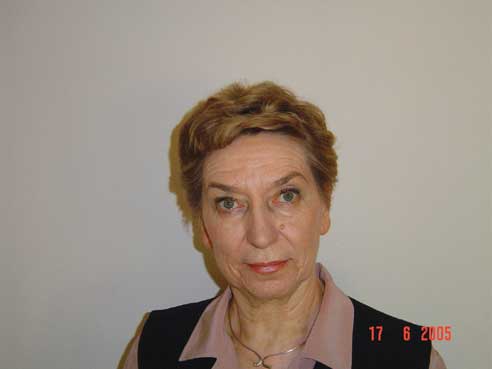 |
| Professor Vesna Roje from the University
of Split, FESB, started the process of forming the Croatia
EMC Chapter in February 2005. |
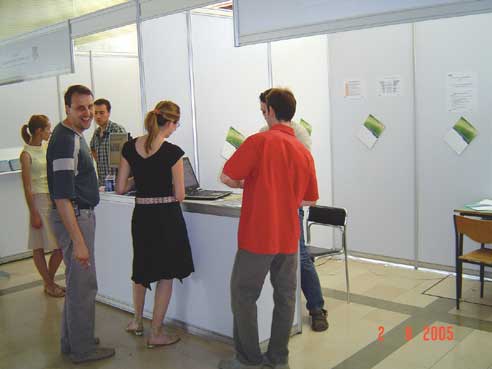 |
| Students, engineers, and faculty
visit the Croatia EMCS “Career Day” booth held at
the University of Split, FESB. |
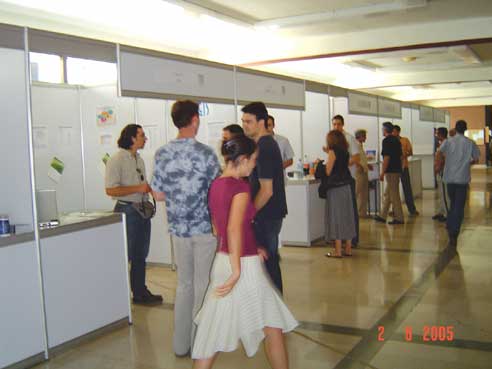 |
| The Croatia EMCS “Career Day”
booth held at the University of Split, FESB drew plenty of
attention. |
Welcome New Chapter: Croatia
The Croatia Chapter has been formally accepted into the EMCS fold
and will likely hold their first “formal” meeting in
September. They hope to have an IEEE EMCS Distinguished Lecturer
and/or an EMC Society BoD member present for the festivities.
Organization of the Croatia Chapter began in 2004 and was led
by Professor Vesna Roje of the University of Split. During the
organizing process, 14 signatures were gathered from members of
the IEEE EMC Society in Croatia. The Chapter was formally recognized
in March 2005. Although the inauguration meeting of the Chapter
has not yet occurred, they have already begun to encourage researchers,
engineers and students to become members of the IEEE and EMC Society.
The Chapter was represented in July at the University of Split,
FESB Career Day. The Croatia Chapter members had many opportunities
to explain the benefits of being a member of the IEEE and the
EMCS. Croatia will start out as a small Chapter but they are willing
to improve membership through the tighter connections with the
IEEE. They strongly believe that the future lies in the inclusion
of young people in technology professions. On July 2, the Chapter
members and interested guests held a small organizational meeting.
Professor Roje, Chapter chair, gave a short report analyzing the
participation of the Chapter at the Career Day at the University
of Split, FESB (Faculty of Electrical Engineering, Mechanical
Engineering and Naval Architecture). The future activities and
the plans for the inauguration meeting were also discussed.
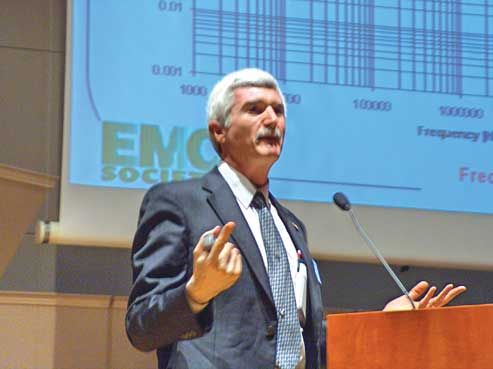 |
| Elya Joffe during his presentation
at the inaugural meeting of the EMCS Poland Chapter. |
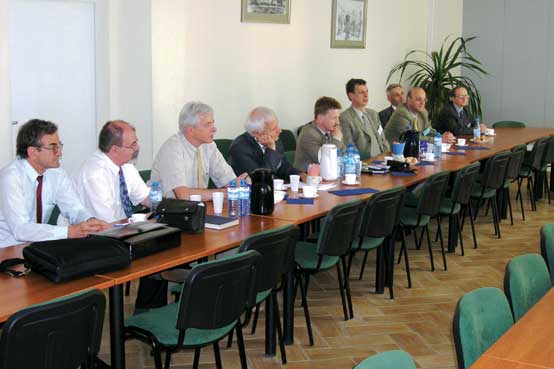 |
| Attendees of the Poland Chapter meeting
(from left) Wojciech Gwarek -MTT Society Distinguished Lecturer,
Maciej Walkowiak, Wojciech Krzystofik, Andrzej Sowa, Miroslaw
Zielenkiewicz, Wojciech Pluta, Ryszard Zielinski, Andrzej
Kucharski, and Fryderyk Lewicki. |
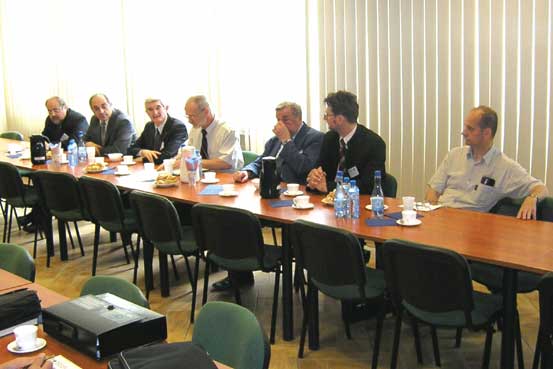 |
| Attendees of the Poland Chapter meeting
(from left) Marian Soinski, Tadeusz Wieckowski, Elya Joffe,
Andrzej Karwowski (Chapter founder and Chair), Daniel Bem,
Krzysztof Sieczkarek, and Wojciech Bandurski. |
 |
| Attendees of the Poland Chapter meeting
(from left) Tadeusz Wieckowski, Elya Joffe, Andrzej Karwowski,
and Krzysztof Sieczkarek. |
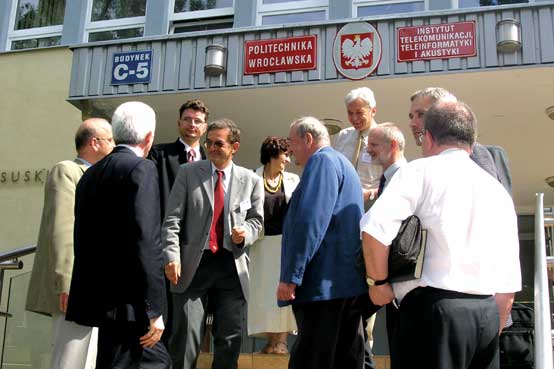 |
| Poland Chapter attendees relaxing
after their June 30 meeting. |
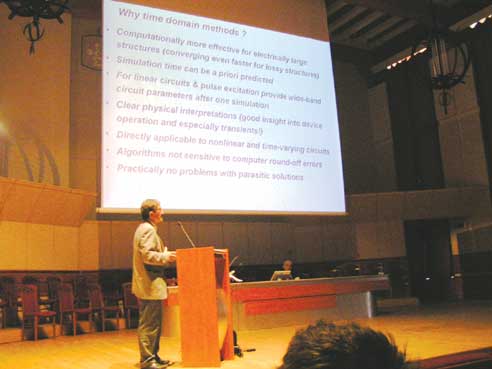 |
| Professor Gwarek explains advantages
of time-domain EM simulation methods. |
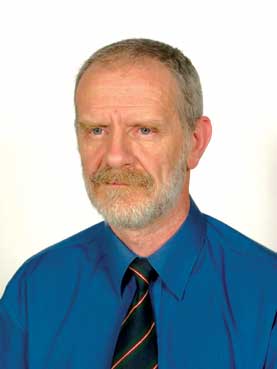 |
| Andrzej Karwowski, Poland Chapter
founder and Chair. |
Welcome New Chapter: Poland
The newly registered IEEE Polish EMC Chapter held its inauguration
meeting on June 30 in Wroclaw. The meeting was hosted by the Wroclaw
University of Technology (WUT), Wroclaw, as an event joined with
a three-day (June 29 - July 1) 5th National Workshop on Electromagnetic
Compatibility organized by the Institute of Telecommunications,
Teleinformatics and Acoustics, WUT, in cooperation with the national
regulatory authority, i.e., the Office of Telecommunications and
Post Regulation. On June 30, the technical sessions and social
events (including a banquet) of the Workshop were open at no charge
to Chapter members. The technical program included a morning plenary
session with two excellent presentations delivered by the invited
speakers. One presentation, “Frequently Asked EMC Questions
(and Answers)” was given by Elya Joffe, EMCS BoD Member.
A second presentation was given by Professor Wojciech Gwarek from
Warsaw University of Technology, Poland, Distinguished Lecturer
of IEEE MTT Society, entitled, “Application of Modern EM
Field Simulators for Designing High-Frequency Passive Structures.”
Over 70 people attended the technical session. The administrative/organizational
meeting was opened at 2:00 PM by one of the Chapter founders and
nominated Chairman of the Chapter, Professor Andrzej Karwowski
(Silesian University of Technology, Gliwice). Professor Karwowski
welcomed honorary guests: Elya Joffe, VP of the EMC Society, and
Professor Daniel J. Bem, Chair of EMC Section of the Committee
of Electronics and Telecommunications, Polish Academy of Sciences,
as well as the Chapter members who attended the meeting. After
the round of introductions, Andrzej briefed members on the status
of the Chapter having 27 active members. Then, Elya Joffe passed
on the EMCS BoD’s message to the Chapter. Elya also gave
a presentation entitled, “IEEE and EMC Society Membership...
Why?” explaining the benefits of joining IEEE and EMCS. Before
closing the meeting, Andrzej expressed thanks to Mr. Joffe for
joining the inauguration meeting of the Polish EMC Chapter, and
gratitude to Professor Tadeusz Wieckowski, VP of the Wroclaw University
of Technology, and Chairman of the Workshop, for providing rooms,
equipment, technical assistance and significant financial support
for the meeting. Here is a little more about Professor Andrzej
Karwowski, chairman of the new Polish Chapter. Professor Karwowski
received the M.Sc., Ph.D., and D.Sc. (Habilitation) degrees in
electronics in 1969, 1976, and 1984, respectively, from the Wroclaw
University of Technology (WUT), Wroclaw, Poland. From 1969 to
1984 he was with the WUT, Wroclaw, holding academic positions
from Assistant to Associate Professor. From 1985 to 1986, he was
with the Wroclaw Branch of the National Institute of Telecommunications
– a telecom R&D center active in the fields of network
development and national/international standardization of communication
systems and equipment. In 1987, he joined the faculty of Automatic
Control, Electronics and Computer Science, Silesian University
of Technology, Gliwice, Poland, where he currently holds a position
of a Professor. Dr. Karwowski’s research interests are generally
in electromagnetic engineering, specifically in development and
application of numerical modeling techniques to radiation, scattering
and coupling problems. For many years, Dr. Karwowski has served
as a member of the Program Committee of the International Wroclaw
Symposium and Exhibition on EMC. Due to his contributions to this
Symposium, he has been appointed to be Chair of the Program Committee
since 2004. Dr. Karwowski also serves as a Vice Chair for AP-S
of the AES/AP/MTT Joint Chapter, Poland Section of the IEEE.
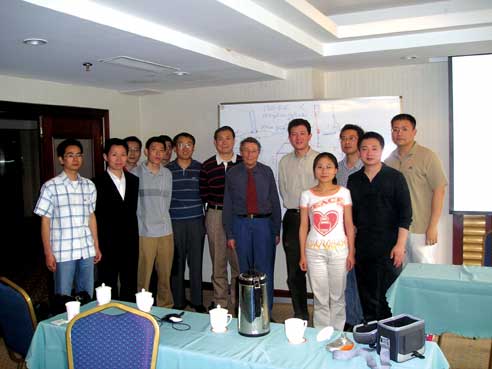 |
| Attendees gather after Dr. Ianoz’
lecture in Nanjing organized by the Beijing Chapter, including
(from left), Zhou Xushen, Lu Shuyan, Professor Gao Cheng,
Yi Yun, Professor Shi Lihua, Professor Ianoz, Mi Jianping,
Yang Guohua, Guo Hong, Lizicheng, Chen HaiLin, Dr. Yu Tong
Bin, and Ren Heming. |
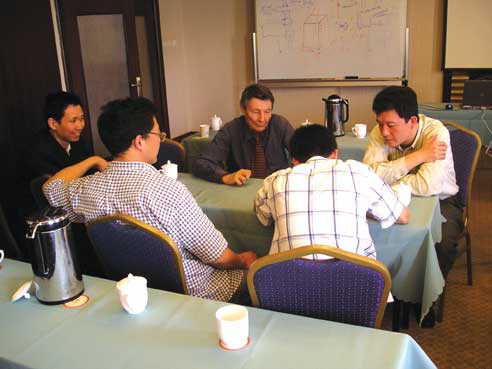 |
| Nanjing attendees discussing the
presentation of Dr. Ianoz included (from left to right) Professor
Shi Lihua, Ren Heming (graduate student), Professor Ianoz,
Professor Gao Cheng and Dr. Yu Tongbin. |
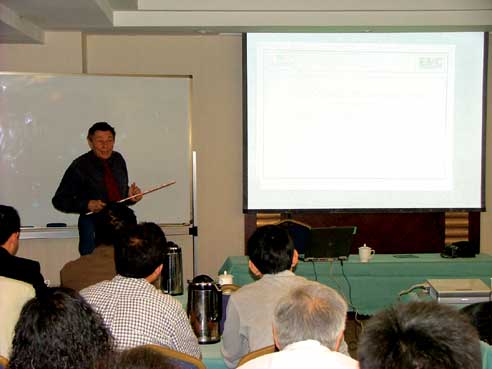 |
| Dr. Ianoz during his May presentation
to the Beijing Chapter in Nanjing, China. |
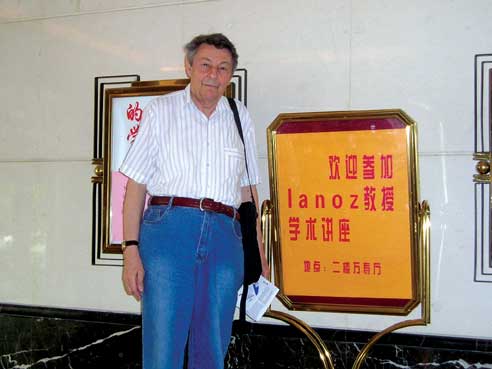 |
| Professor Ianoz pictured at the welcome
sign before his presentation in Nanjing, China. |
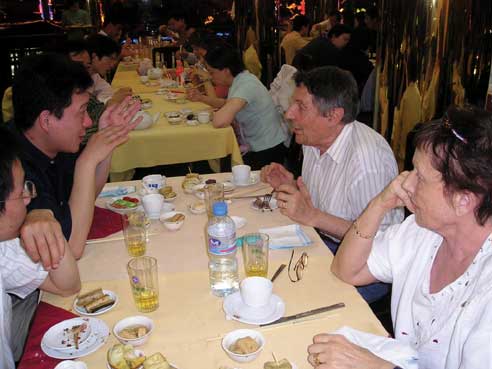 |
| Professor Ianoz and his wife enjoyed
the local foods after his Nanjing, China presentation. Pictured
also are Professor Shi Lihua (top left) and Ren Heming (top
right). |
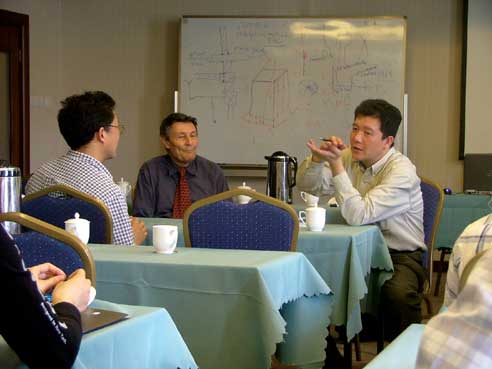 |
| Professor Ianoz, Professor Shi Lihua
(right) and Professor Gao Cheng (left) enjoy a technical discussion
during one of the breaks at the meeting in Nanjing. |
Beijing
On the invitation of Professor Gao Yougang, Chairman of the EMC
Chapter, Beijing Section, IEEE, Professor Michel Ianoz visited
Nanjing, a beautiful city in the southeast of China. During his
stay in Nanjing, Professor Ianoz was invited to give a lecture
to the students and teachers in the local universities. The lecture
was held by Nanjing Engineering Institute and was presented at
the Lijin Garden Hotel in Nanjing on May 18.
The lecture started at 9:00 in the morning and ended at 12:30.
During the three and a half hours, he made two presentations.
The topics were lightning electromagnetic effects and field-to-transmission
line coupling computational methods. The audience was from South
East University, Nanjing University of Science and Technology,
Nanjing Institute of Post & Telecommunication and Nanjing
Engineering Institute. Since 2002, Nanjing Engineering Institute
has been using the book EMC Analysis Methods and Computational
Models co-authored by Drs. Frederick M. Tesche, Michel Ianoz,
and Torbjörn Karlsson as a text book for graduate students.
Most of the students taking the class in this school term attended
the lecture. After the lecture, Professor Ianoz held a two hour
discussion in the afternoon. He answered the questions posed by
the audience and introduced to them some papers that contain further
information. The research group on lightning electromagnetic pulse
at Nanjing Engineering Institute is working in the direction very
close to the topic of the lecture. They discussed with Professor
Ianoz about the lightning return stroke model, calculation of
LEMP environments near the lightning channel, coupling analysis
and measurement techniques. Over the past few months, a number
of other, excellent presentations were also given to the Beijing
Chapter. Each was well attended by IEEE members and non-members.
For example, following is a list of the meetings:
-
On May 16, “Antennas
for UWB Applications,” by Doctor Zhi Ning Chen.
-
On May 26, “EMC
in Structural Design: Framework, Standards, Spectrum, and RF
Circuits” by Professor Quan Xin Jiang.
-
On May 27, “EMC
in Structural Design: Shielding, Grounding, Connecting and Filtering,”
by Associate Professor Zhong Yuan Li.
-
On May 27, “High
Power EM Pulse and Protection” by Professor Bi Hua Zhou.
-
On May 27, “EM
Scattering and Radiation in RF EMC,” by Professor Jin Ping
Xu.
-
On June 9, “Closed
Form Green’s Functions for Planar, Cylindrical, and Spherical
Geometries: Fundamental Issues,” by Professor Le Wei Li.
-
One June 9, “Simple
Formula of a Patch Capacitor on a Grounded Substrate of Two
Layers,” by Professor Y. Leonard Chow.
-
On June 10, “Characterization,
Design, and Synthesis of Metamaterials of Low Loss and Broad
Bandwidth,” by Professor Le Wei Li.
-
On June 13, “Introduction
of Galileo Satellite Navigation System with Applications,”
by Professor Gustavo Balfort.
-
On June 20, “Antennas
and Propagation for Galileo Satellite Navigation System,”
by Professor Paola Pirinoli.
-
On June 21, “Unconditionally
Stable FDTD algorithms â€, Myth or Reality?”
by Professor Ji Chen.
Central New England
John Clarke reports that the Central New England Chapter held
two meetings to date during 2005. Boris Shusterman and John Clarke
have continued as Co-Chairs of CNEC/EMCS during 2005. On Wednesday,
April 27, the CNE Chapter held a meeting dealing with the subject,
“Ferrite Cores for EMI Suppression”. The speaker was
Paul Zdanowicz of Fair Rite Products Corporation, Walkill, New
York. Whether designing or testing, his presentation helped engineers
and technicians to understand the basic operation of ferrite materials
and components. Learning about the various ferrite materials available
and their performance characteristics will help individuals to
quickly find the solution for any particular application. Paul’s
presentation contained information which will assist the attendees
to specify and choose ferrite components for EMI suppression.
The speaker covered the basic operation of ferrite material followed
by an in depth discussion of EMI suppression and the significance
of test methods on components for particular applications. In
attendance were 18 IEEE members and 16 guests. (Most IEEE members
were also EMCS members.) The CNE Chapter held its 2nd meeting
of 2005 on Wednesday, June 22. The topic was, “Taking the
Guesswork Out of EMC/EMI Design,” by David P. Johns, Ph.D.,
Vice President of Electromagnetic Engineering, Flomerics, Inc.
In the past, EMC/EMI design has been far from an exact science.
EMC/EMI engineers have not always been able to say, “Do it
like this and it will work”. Instead, by drawing on past
experience and applying general design guidelines, engineers have
said, “Do it like this and it may work”, or, “This
is more likely to work, but at a higher cost”. To make matters
worse, EMC/EMI design is a constantly moving target. The electromagnetic
environment is flooding, due to the proliferation of wireless
communications devices. Electronics products are emitting higher
frequencies due to faster switching and circuits are becoming
more sensitive to interference. Design techniques that worked
in the past may not work in the future. Considerable guesswork
is involved. There is a growing desire for EMC/EMI engineers to
identify problems earlier in design, to be more definite and accurate
in their recommendations and to minimize the test, fix, re-test
cycle, enabling products to pass compliance and enter the market
quicker. Electromagnetic simulation tools have matured considerably
over the last five years and offer tremendous opportunity for
EMC/EMI engineers to work more effectively and with greater confidence.
Dr. Johns’ presentation included examples of electromagnetic
simulation applied to real-world EMC/EMI design problems, emphasizing
the value that simulation offers over and above general design
rules. For this presentation, we had 29 attendees, consisting
of 11 IEEE (6 EMCS members) and 18 guests. The next CNE Chapter
meeting is scheduled for September 2005.
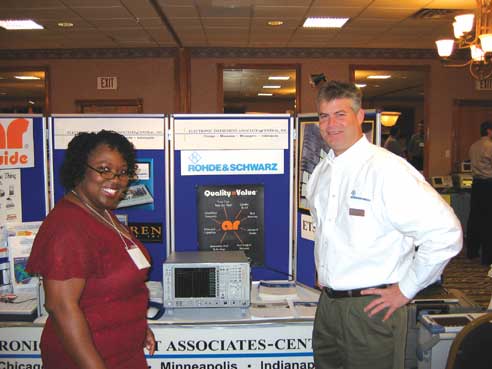 |
| Carla Robinson of US Robotics discusses
a new Rohde & Schwarz receiver with Vic Hudson at the
booth of Electronic Instrument Associates during the Chicago
MiniSymposium. |
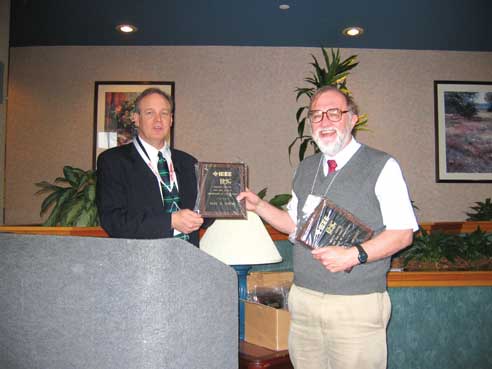 |
| Jack Black, Chicago Chapter Chair,
presents two plaques to Don Sweeney (right) of DLS Electronic
Systems for speaking at the MiniSymposium. |
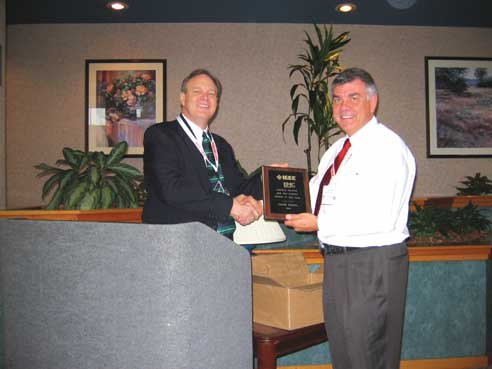 |
| Jack Black, Chapter Chair, presents
Frank Krozel of Electronic Instrument Associates with the
“EMC Person of the Year” Award. |
 |
| Frank Krozel, Chairman, EMC MiniSymposium,
introduces to the attendees Tom Braxton, Chairman of the 2005
IEEE Symposium on EMC (center) and Jack Black, Exhibits Chairman
(right). |
Chicago
The Chicago Chapter held another successful EMC MiniSymposium.
Many new manufacturers were in attendance at this eighth annual
event. Chicago is pleased to announce that they actually sold
out on booths this year! The speakers had riveting presentations
and all in attendance left with new insights in EMC. A special
thanks to all the speakers from the Chicago Chapter.
France
The French Chapter enjoyed two very interesting technical presentations
on June 27th. First, a paper on the “Study of Low-Frequency
Electromagnetic Problems Using Static and Quasi-Static Methods”
was given by Alain Reineix (Université de Limoges). Next,
Yannick Béniguel (IEEA) spoke about, “Use of the Method
of Integral Equations for Magnetostatic Problems.” The French
Chapter is also involved in the preparation of the symposium on
embedded EMC to be held in Rouen on 26-27-28 September 2005. Please
see the French Chapter Website at https://e2mc.esigelec.fr
 |
| Officers of the Germany Chapter welcome
key note speakers Nigel Carter (second from right) and Elya
Joffe (second from left) to their EMC Workshop on April 18. |
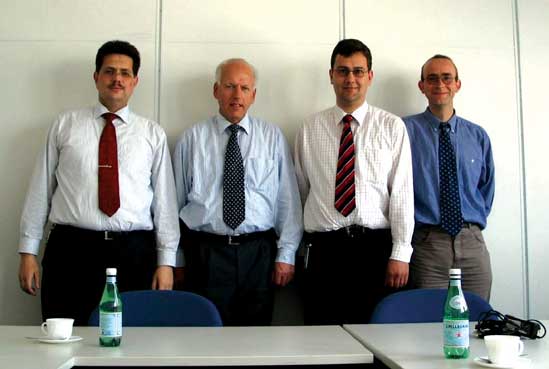 |
| Germany EMC Chapter officers gather
for a meeting in April. |
Germany
The IEEE German EMC Chapter held a one day workshop on April 14,
2005. Numerous technical presentations were given on aircraft
system related EMC topics. After a welcome of speakers and attendees
by the vice chair Jan Luiken ter Haseborg, the technical program
started with a visit to the EMC laboratory at the Hamburg University
of Technology. During the morning session speakers addressed topics
such as protection against ultra-wideband signals, conducted and
radiated RF propagation in aircraft systems and measurement of
ultra-wideband field signals. After mental and physical refreshment
during the lunch break, the workshop conducted with presentations
delivered by the two key note speakers Nigel Carter and Elya Joffe.
Nigel Carter is the Technical Manager for Electromagnetic Environmental
Effects (E3) in the Electromagnetics Group, of QinetiQ, in the
UK. Nigel has been working in the field of E3 for over 30 years.
His primary work is research in the development of test and analysis
methodologies for assessing the vulnerability of both civil and
military land, sea and air assets to electromagnetic environmental
effects. His work has produced test procedures that have been
encompassed in various forms in national and international standards.
In his presentations on “The EM Environment of Modern Aircraft”
and “Aircraft HIRF Test Techniques” he shared his outstanding
experience and knowledge with participants. In his presentation
on the EM environment, he stressed the aspect that the environment
definition, testing, and aircraft specification is a result of
a delicate balance between cost and safety. After a detailed survey
over past investigations and a characterization of internal and
external environments, he turned to current and future challenges
and problems. Of particular interest were the increasing use of
electronics in critical areas, and the reliance on electronic
sensors in combination with new (non metallic) materials resulting
in increasing vulnerability against electromagnetic fields. Nigel
closed his first presentation with a comparison of civil and military
environment definitions. In his second presentation, Nigel answered
the question how the hardness of an aircraft against high intensity
radiated electromagnetic fields (HIIRF) can be tested. Starting
with the idea of a perfect test, he presented existing test facilities
for whole aircraft field testing. Due to physical and legal restrictions
as well as to cost, whole system tests are not always possible.
To solve this problem, Nigel Carter introduced the participants
to the concepts of alternative test techniques, like the Low Level
Swept Current Test (LLSC), the Low Level Swept Field Test (LLSF)
or the High Level Direct Drive. Elya Joffe, the second key note
speaker, is the Vice President for Engineering at K.T.M. Project
Engineering in Kfar Sava, Israel, and works as a Senior EMC engineering
specialist and consultant. He has over 20 years of experience
in government and industry, in EMC/E3 for electronic systems and
platforms (in particular, aircraft and aerospace). He is actively
involved, as an EMC/E3 specialist, in the EMC design of commercial
and defense systems, from circuits to full platforms. His work
covers various fields in the discipline of EMC, as well as numerical
modeling for the solution of EMC problems. Elya is a very popular
speaker with many IEEE EMC Chapters and similar organizations
around the globe. His presentation on “EMI Anomalies and
Their Solutions” complemented the speeches of Nigel Carter.
Elya started with a survey of EMI sources, he continued background
information on EMC standards, and delivered a fruitful collection
of EMI cases, which pointed out various aspects of EMI. The cases
covered power supply interactions, coupling to instruments, filter
and bonding problems, and unpredicted interference between certified
equipment. The intensive discussion of all cases, problems and
solutions, confirmed the high interest of all participants in
the presented material. At the end of the workshop, the chair
of the German EMC Chapter, Frank Sabath, thanked all speakers
for their presentations and Jan Luiken ter Haseborg for his support
and hosting the workshop. He pointed out that the slides of the
key note speeches can be downloaded from the home page of the
German Chapter (www.ewh.ieee.org/r8/germany/emc).
Lastly, he announced that the German Chapter is organizing a workshop
on numerical field computation, which is scheduled for May 2006.
 |
| Leo Makowski receives a sample of
shielding materials from Gary Fenical at the Central New England
(CNE) Chapter’s May meeting. Also pictured are Past Chapter
Chairman PJ Modin (far left) and Patrick Griffin (far right). |
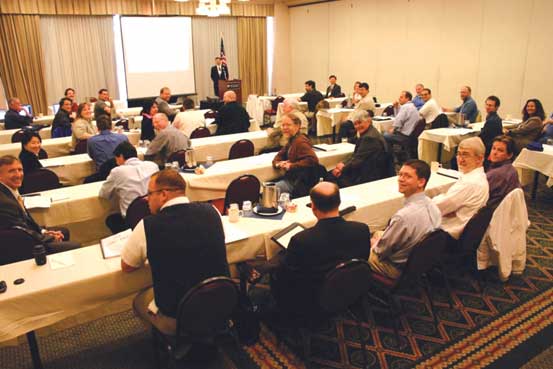 |
| Member introductions at the start
of April’s Portland Product Compliance Colloquium and
Exhibition. Can you find Todd Hubing in this photo? |
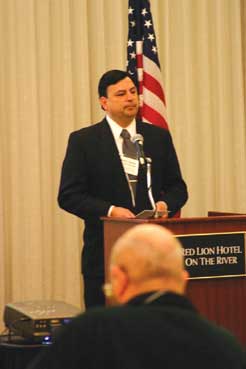 |
| Henry Benitez, President of Electromagnetic
Investigations, LLC, and Colloquium Co-Chair. |
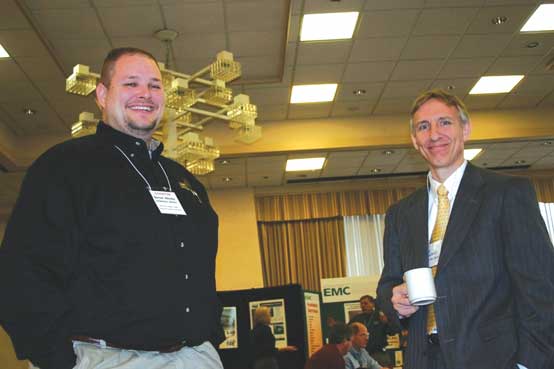 |
| Derick Skouby and Dr. Todd Hubing
take in the Vendor Exhibits, as always a popular part of an
EMC Colloquium. |
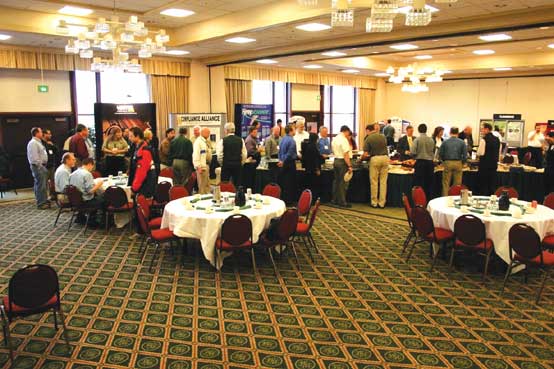 |
| After a full morning of informative
presentations, Colloquium participants line up for lunch in
the Vendor Exhibition Room, for refueling, camaraderie, and
networking. |
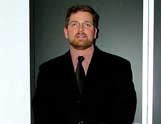 |
| Clark Vitek spoke at the May meeting
of the Oregon and SW Washington Chapter. |
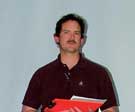 |
| Dave Britton (Chapter Chair) presided
over the May meeting in Portland, Oregon. |
Northern Virginia-Washington DC
Leo Makowski, Vice-Chair for the Washington DC/Northern Virginia
Chapter, reports that they just held their 3rd meeting of 2005
and are now taking their summer recess. The most recent meeting
was held on Thursday, May 19 at Marriott’s Wardman Hotel.
Gary Fenical from Laird Technologies gave a presentation on “New
Developments in Shielding Materials.” His presentation was
kept lively with Gary’s incorporation of real-world examples
of how the technology is used by industry and cost savings are
being made. In addition to the many questions from the audience,
the showing of different types of material now being used for
shielding materials kept his talk very interactive. The manufacturing
challenges of the highly integrated and complex products, cell
phones, PDAs, radios, etc, are of particular interest. As Gary
pointed out, the shielding is necessary for device function, as
opposed to solely meeting regulatory requirements. After Gary’s
presentation, Mike Violette of Washington Laboratories gave an
update on the progress being made on the Chapter’s bid to
host the 2010 IEEE EMC Symposium. Many of the attendees were interested
in being part of the committee to bring the conference back to
the DC area. Everyone is eagerly awaiting the Society’s decision
later this year. The Chapter’s next meeting is scheduled
for September 15. For more information, contact Leo Makow-ski
at makowski@hvtechnologies.com.
Oregon and SW Washington
In April, the Oregon and SW Washington Chapter and the Product
Safety Technical Committee (PSTC) held their planned joint Portland
Product Compliance Colloquium and Exhibition. The well-attended
Colloquium featured technical presentations on EMC, Product Safety,
and Environmental Regulatory topics. Speakers and specific topics
included:
Mr. Henry Benitez: Product Compliance Standards
and Regulations
Dr. Daniel Ma, for Dr. Ruud Overbeek: WEEE & ROHS Directives
for Electrical and Electronic Equipment
Dr. Todd Hubing: EMC Design at the Printed Circuit Board Level
Integrated Circuit EMC System Level EMC
Mr. Richard Nute: Effective Safety Certification Processes Root
Causes for Portable Power Supply Recalls Preview of the IEC Hazard-Based
Standard – Electrically-Caused Injury
The May chapter meeting featured a presentation
by Clark Vitek, Senior EMC Engineer with Extreme Networks, Inc.
A member of CISPR Subcommittee A Working Groups 1 and 2, he has
attended CISPR SC/A meetings as a United States delegate since
June 2000 and since 2004 has served as the Technical Advisor for
the US National Committee of the IEC for CISPR SC/A. He has served
as project leader for working group projects on measurement facility
validation and measurement methods above 1 GHz. He is also presently
the convener of a CISPR SC/A and SC77B Joint Task Force on Fully
Anechoic Rooms. Drawing from his recent and current CISPR work,
Mr. Vitek’s presentation on “Site Validation above 1
GHz (CISPR Proposals)” provided his audience with valuable
insights into what new site validation work would be required
to implement the new CISPR “reflection-free” test protocols
under consideration. Information about future chapter meetings
can be found at the following web site: https://www.
worldaccessnet.com/~emc/
 |
| Daryl Gerke speaks to the Phoenix
Chapter on using differential diagnosis to troubleshoot radiated
emissions. |
 |
| Dr. Heyno Garbe speaks to the Phoenix
Chapter on understanding and avoiding EMC problems with LAN’s. |
Phoenix
Harry Gaul reports that in April, the Phoenix EMC Chapter welcomed
their very own Daryl Gerke to speak. Daryl gave a well-received
talk on “Diagnosing and Troubleshooting EMI Problems”.
He began the talk by sharing his philosophy of troubleshooting,
which he has refined over many years of being an “EMI guru”
troubleshooter. First, he stated that one has to develop an “emergency
room” mentality with a fast response because the “patient”
is often in pain. The initial information is often confusing or
incomplete. And, the situation may also be tense, so the troubleshooter
has to keep cool. The first step is to diagnose and then try fixes
because “prescription without diagnosis is malpractice”.
Daryl offered up many examples of failures and fixes ranging from
ESD to emissions to power disturbances. He also addressed the
pros and cons of fixes implemented at the board level versus at
the enclosure level. Daryl shared the contents of his magic box
of tricks including foil, copper tape, screen, ferrites, and EMI
filters. Daryl concluded his talk by emphasizing the need to first
diagnose the problem through the gathering and critiquing of data
followed by making a plan. The actual fixing of the problem then
involves iterating between predicting and monitoring the outcome
of fixes. On May 25, the IEEE EMC Phoenix Chapter meeting was
held at Garcia’s Mexican Restaurant in Tempe. After Chapter
business, Harry Gaul introduced our featured speaker, Professor
Dr. - Ing. Heyno Garbe, a Distinguished Lecturer of the EMC Society.
Professor Garbe is currently Dean for Education at the Department
of Electrical Engineering and Information Technology at the University
of Hanover, Germany. Professor Garbe is very active in several
EMC related national and international standardization committees.
He is a Senior Member of the IEEE, as well as a member of URSI
Com. E, VDE, and the IEEE EMC, AP, IMT and MTT Societies. Since
1997, he has served as chairman of the German Chapter of the EMC
Society and is currently serving on the Board of Directors of
the EMC Society. Professor Garbe started his presentation “Understanding
and Avoiding EMC Problems of LANs” by covering the basic
fundamentals of attenuation and Near End Cross Talk (NEXT). He
spoke of field coupling to several kinds of wire structures, and
the effects of common mode to differential mode transformation
in balanced versus unbalanced transmission lines. He defined LAN
cable structures and their uses including internal shields which
tend to reduce wire-to-wire crosstalk, and overbraid shields which
reduce field to cable coupling. He also covered digital noise
sources that one may encounter in a LAN system. For instance,
LAN-emitted digital noise tends to be stochastic and it is important
to calculate the power spectral density to ascertain if a noise
problem may be evident. Interestingly, Professor Garbe showed
a graph which compared the power spectral densities of 10, 100
and 100 base-T Ethernet signals, which showed that 10 base-T signals
have the highest amplitude in the lower frequency ranges. If a
system tends to be susceptible in the 10 base-T range, then the
10 base-T emitter would be worst-case among the three. The important
thing to understand is that the digital encoding affects the potential
of susceptibility. Professor Garbe also mentioned the importance
of a well terminated cable shield. Terminating a cable shield
at one end is not enough. Dr. Garbe showed experimental results
indicating that a one-end terminated shield would have the same
shielding effectiveness as a completely unshielded cable at higher
frequencies where LAN noise is prevalent. He joked that one could
save money by simply avoiding all shielding if the design included
one-end termination. He also spoke of long pigtail terminations,
which are responsible for poor shielding effectiveness. One conclusion
that that he drew was that the radiated emissions from LAN cables
due to the differential signal is pretty small because of the
balanced nature of the signal. The more severe threat is power
supply chopper noise which may be present on the LAN wiring. In
this case, the power supply noise is common mode so the twisting/balancing
provides no reduction. Thus, the shielding of the twisted pairs
is necessary to reduce the emissions. Finally, Professor Garbe
covered the increasingly popular Broadband Power Line Communications
Systems, which of course are not shielded. He implied that these
are noisy systems indeed. Several questions arose at the end of
the talk, including a lively and positive exchange discussing
the importance of maintaining a ‘balanced’ design. Information
on future meetings is available on the Phoenix EMC Chapter Web
site at https://www.ewh.ieee.org/r6/
phoenix/phoenixemc/.
 |
| Clark Vitek of Extreme Networks (far
right) welcomes Seattle Chapter members to the May meeting
held at CKC labs in Redmund, Washington. |
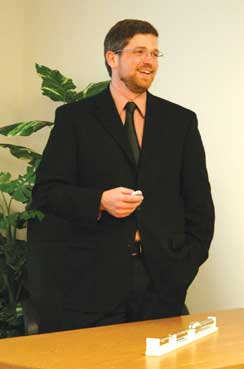 |
| Mr. Vitek appreciated the extended
question and answer period following his presentation to the
Seattle chapter. |
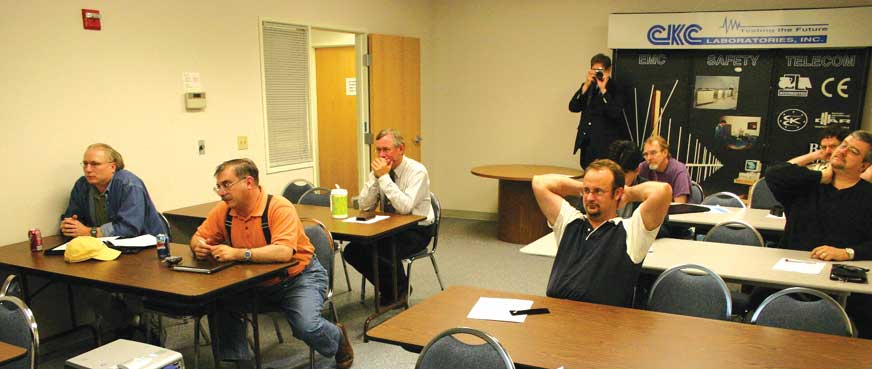 |
| Attendees intently listen to Clark
Vitek’s presentation to the Seattle Chapter. Harry Hodes
of Acme Testing (in orange shirt) in particular kept discussion
lively following the presentation. |
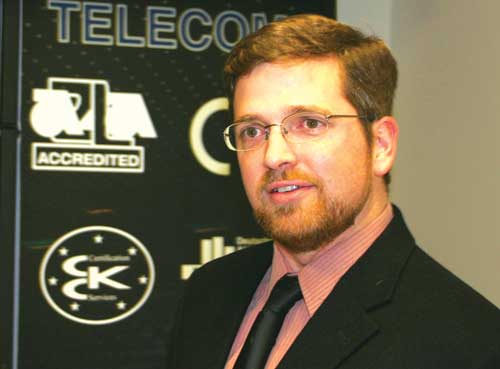 |
| Up close and personal with Clark
Vitek at the Seattle Chapter meeting. |
Seattle
In April, there was no regularly scheduled meeting as the Chapter
traveled south to attend the Oregon and SW Washington Chapter
colloquium and exhibition. In May, regular Chapter meetings resumed.
Clark Vitek of Extreme Networks was the invited speaker. The meeting
was held at CKC Labs in Redmond on May 24. A dedicated audience
representing test labs (CKC Labs and Acme Testing), industry (Intel
and Philips Medical) as well as representative firms (Lionheart
Northwest and Del Black Associates) came to hear the presentation
on “Site Validation Above 1 GHz”. Since 1999, CISPR
Subcommittee A has been evaluating various proposals to include
in CISPR 16-1-4 for site validation above 1 GHz. This work has
recently reached the first voting stage (CDV) and will be voted
on by December 2005 by the National Committees of the IEC. The
method proposes to use a technique based upon evaluation of site
VSWR, which uses a method that requires no previous antenna factors
or reference measurements in order to evaluate a site. However,
this method also presents some new challenges for existing facilities
in that good quality microwave absorber is typically required
on all surfaces, including the floor, in order to meet the requirement
of the proposed standard. Clark provided an overview on the background
of the site VSWR method and discussed results from various EMC
facilities evaluated by the proposed technique. With his extensive
involvement in CISPR activities, Clark knew first hand much about
the topic. As a member of CISPR Subcommittee A Working Groups
1 and 2, Clark has attended CISPR SC/A meetings as a United States
delegate since June 2000 and since 2004 has served as the Technical
Advisor for the US National Committee of the IEC for CISPR SC/A.
The presentation was followed by a very lively question and answer
period. All enjoyed the simulating discussion, especially the
speaker who appreciated the interest shown. The Chapter will take
the months of June, July and August “off” for the summer
season, and will resume activity on September 20 with an eagerly
awaited presentation by EMCS Distinguished Lecturer, Chris Holloway
of NIST. For more information on the activities of the Seattle
EMC Chapter, visit the Seattle Section website at www.ieee-seattle.org.
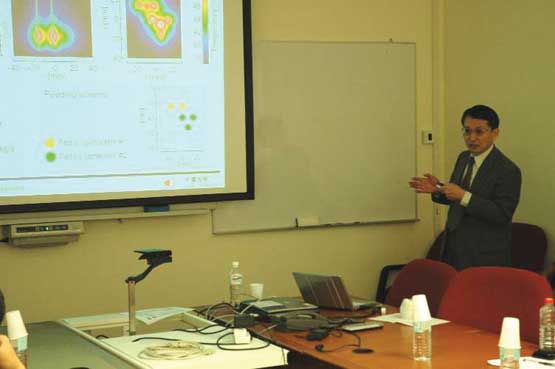 |
| Dr. Koichi Ito giving his presentation,
“Antenna Technology Applied to Medicine” to the
Singapore Chapter. |
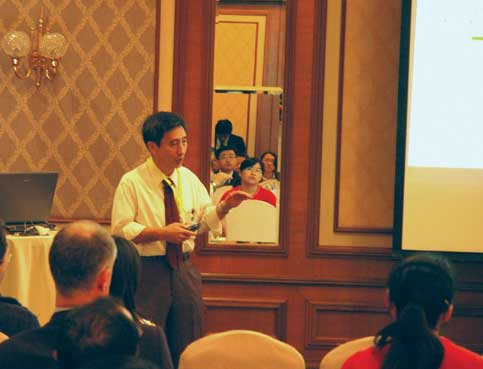 |
| Professor Iton gives a very
popular and well attended presentation to the Singapore Chapter
in March. |
Singapore
The Singapore Chapter recently held several well attended technical
seminars. On March 8, Professor Tatsuo Itoh presented, “Microwave
Devices Based on Composite Right/Left-Handed (CRLH) Transmission
Line Metamaterial.” This meeting was organized by the IEEE
Singapore EMC and MTT/AP Chapters and held at the Marina Mandarin,
Singapore. Just three days later on March 11, Mr. Liu Enxiao,
gave a presentation at the Institute of High Performance Computing
(IHPC), Singapore, entitled, “Analysis of High-Speed Interconnect
by FDTD-Macromodeling Method.” Then, Dr. Koichi Ito gave
a seminar regarding, “Antenna Technology Applied to Medicine”.
This event took place on March 11 at the Institute for Infocomm
Research in Singapore.
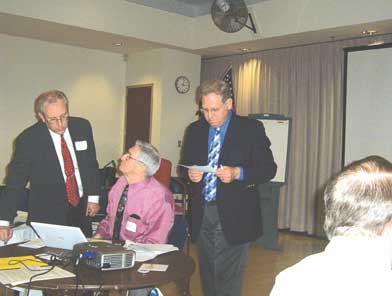 |
| Mark Steffka of General Motors and
the University of Michigan at Dearborn, Henry Ott of Henry
Ott Consultants, and Kimball Williams of Denso International
America (from left) prepare for the start of EMC Fest 2005
organized by the SE Michigan Chapter. |
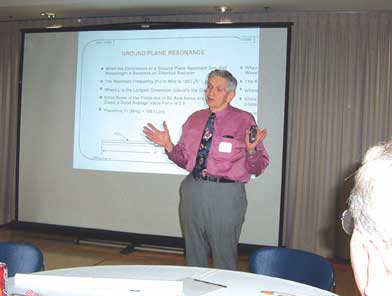 |
| Henry Ott presented “Dipoles
for Dummies” and “Partitioning and Layout of Mixed
Signal PCB” to a rapt audience of over 120 people during
the SE Michigan’s EMC Fest 2005. |
SE Michigan
To those of us who have rail guns languishing in our basements,
the Naval Railgun launching presentation on February 16 by Lt.
Seth Miller to the SE Michigan chapter was inspiring. Naval railguns
are potentially more robust than present technology because they
have much of their targeting information determined at the time
of launch. A shipboard naval railgun should be able to deliver
a projectile at a range of 200 nautical miles in 6 minutes with
a Mach 5 terminal velocity. Discussion of engineering conundrums
being encountered by the Naval Railgun team invoked lively discussion
as potential ways to channel high magnetic fields and coolant
at the same time was discussed. A favorite moment of the speech
was when Lt. Miller noted that when the railgun cables were unbalanced,
the whole I-beam assembly used to launch projectiles was severely
deformed. On March 16, the National Radio Quiet Zone (NRQZ) presentation
by John Ford to the SEM chapter ended with an invitation to all
attending to visit the Robert C. Byrd Green Bank Telescope (GBT),
a 100 meter diameter radio telescope nestled in the Deer Creek
Valley in Eastern West Virginia. John Ford, Electronics Division
Head at GBT, discussed the difficulties of keeping the facilities
quiet enough to utilize the radio telescope. They had to repackage
all the high efficiency lights in the facility in order to keep
the facility quiet enough to allow use of the radio telescope.
Facility engineers also ended up finding illegal taps into the
nearby cable television system because of the radiation resulting
from them. On May 3, the Chapter’s annual EMC Fest one day
colloquium and exhibition was held. Over 120 people attended!
The speaker was industry renowned Henry Ott. Mr. Ott reminded
us that it was not the radiation of the individual components
so much as the radiation of the system when he showed us a piece
of equipment that radiated like a loaded top hat dipole. He explained
the reference plane concept of dipoles without using one equation
and allowing us insight into how all conductors are antennas and
those conductors with a nearby reference plane have more radiating
power. This was thoroughly reviewed in his “Dipoles for Dummies”
presentation. In his presentation titled “Partitioning and
Layout of Mixed Signal PCB,” he explained how we should never
put holes in the middle of ground planes due to the trouble it
causes. EMC
|
|
|






































